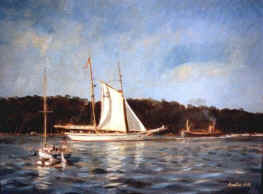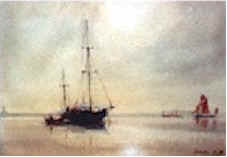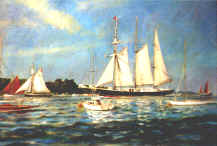|
WELCOME
to The OLD LUGGERS
online-ACADEMY
of
MARINE PAINTING
INTRODUCTION
please
begin here
|
home
equipment & colours preparation drawing & composition
shore
sea & sky useful links
demonstration
The Newfoundland Project
THE
OLD LUGGERS
INTRODUCTION
TO
MARINE
PAINTING
|
'TINA
V at ROCHESTER'
Oil by
Austin Hill

|
Given that we’re
all painters of sorts, from aspiring amateur to polished professional,
what follows will either be amazing revelation or hoary old hat - it can’t
be helped. But I guess we’re all nuts about boats and all we have to do
is turn inspiration into productive obsession. |
One way to get this process moving is to see how the past
masters did it.
Coffee table books of ‘collected works’ abound but to see how the paint was
handled it’s best to see actual paintings up close – people are often
surprised by the ‘mess’ of paint and texture they see standing six inches
from a Turner. You probably know where the best marine pictures are - National
Maritime Museum at Greenwich, Tate Gallery, National Gallery in Trafalgar
Square, at the Head Office of P&O, 79 Pall Mall, London – (by application
if your lucky! - but what pictures!), Metropolitan Museum of Art, New York,
Winslow Homer Museum, Prout’s Neck, Maine, National Gallery of Art, Washington
D.C. – to say the least! See some of the best of modern work at the Royal
Society of Marine Artists, Pall Mall Galleries, London.
And whose work should we look for? Well, this is my choice: J.M.W. Turner,
John Sell Cotman, A.V. Copley Fielding, Benjamin Tindall, George Chambers,
Edward William Cooke, Thomas G. Dutton, Winslow Homer, Charles Pears R.O.I, John
Spurling, Charles Dixon, Montague Dawson and, holy grail! – Van de
Velde, Simon de Vlieger and all the Dutch masters of the 16th,17th and 18th centuries. If you want to know how to
paint warships
 |
The Bermudan Yawl 'Lilymaid
II' in Dover Harbour - Watercolour by Austin Hill |
at sea, look for William Lionel Wyllie,R.A., Alma Claude Burton
Cull, Frank Henry Mason and Charles E. Turner. And what will we see? Well marine
pictures divide several ways. The broad division is between professional and so
called ‘primitive’ paintings of which there are thousands commemorating
local ships and events on the walls of dockside pubs everywhere–the rich
testimony of seafaring peoples. The next division is between ‘Ship Portraits’
and ‘Seascapes with Shipping’. Ship portraits – as the title suggests –
have the ship as subject, perhaps with a bit of coastline and one or two other
vessels in the deep background. Sailing ships in particular were often shown in
full side view with all sails set plus house flag, ensigns and pennants and with
the ship’s name clearly displayed. Steamships are also painted like this,
especially the older sail & steam versions but the flared bow of a steamer
makes for an imposing portrait when painted in three quarter view from a low
viewpoint. The seascape with ships calls for a good command of sea and sky
techniques and particularly of composition. Sea battles rate a category of their
own – ships of the line in all their gilded glory locked in fiery combat – a
subject for every cliché of painting extravagance! Finally Sea and Sky, paint
them like Frederick J. Waugh and we’ve arrived.
One of the best painters of ships I know claims to know nothing ‘about
boats’. His soundest of all counsels is ‘paint what you see and it’ll look
O.K.’ I once complimented him on his handling of a radar scanner and he said
‘is that what it is?’ On the other hand we are not always painting
from life but rather creating an artistic fiction. If our subject ship is too
far off we bring it closer or perhaps it went to the breakers’ yard 50 years
ago and we are recreating it from naval architects’ drawings or cased models
(you should see them in the National Maritime Museum!) This is when we need to
know a fair bit about the technical detail.
And you can be pretty sure that your effort will be scrutinized at some stage
by a knowledgeable seadog. My picture of the schooner ‘Malcolm Miller’ had
just gone on show and one viewer commented on a detail. I asked the man if he
knew the ship well and he said ‘Yes, I’m the skipper.’
To get us on our way I’d just say that in marine painting our subject
changes character as we watch, from mirror calm to surging crests, from deep
blue to muddy sludge. It’s a play of infinite variety, an elusive beauty whose
quest will become our obsession. Bon voyage.
.
 |
Schooner
'Malcolm
Miller' at the Tall Ships Race, 1985
Acrylic by Austin Hill |
home
next
..
© Austin Hill 2000
Home Equipment
& Colours Preparation,
Drawing & Composition
Shore, Sea & Sky
Demonstration Useful Links
The Newfoundland Project
Top of this page
The Old Luggers online
Academy of Marine Painting is an ENTIRELY VIRTUAL establishment, a FREE -TO -AIR
leisure and recreational site which we hope you'll enjoy and even pick up some
useful painting hints. Any of the Old Luggers material can be downloaded
and copied for recreational and private but not commercial use. Apart from
the many illustrations reached via the links, all the images in Old
Luggers are from copyright work by British marine artist Austin Hill. And
finally - a LUGGER is a traditional small working boat carrying a
loose-footed four sided sail hung from a yard, but you knew that of
course !



